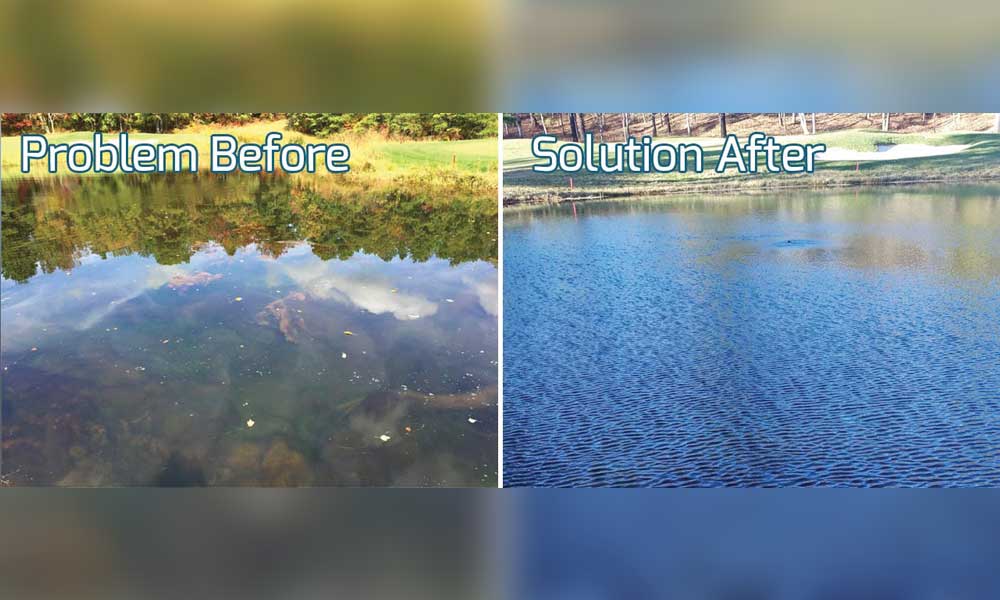BioBoost: Aeration Reinvented


Pond and lake management personnel recognize that aeration is the number one tool to promote healthy, attractive water features. It is no surprise to anyone that manages a waterbody that it can go from centerpiece to eyesore in a few short days. Unfortunately, too often aeration systems are underspecified and potentially improperly installed for the chosen location. There is not a ‘one size fits all’ approach to pond and lake management.
Aeration is a tool that we can use to improve water quality by improving mixing, increasing oxygen content, reducing organic pollutants, improving clarity and ultimately restoring a healthy balance to the waterbodies ecosystem.
The primary device that drives water quality (in waterbodies that have sufficient Oxygen, i.e. aerobic breakdown) is the Nitrogen Cycle. It is responsible for taking organic compounds and breaking them down into their primary parts with the help of specialized bacteria. The Nitrogen Cycle can effectively reduce sludge, leaves, newspapers and anything else in the pond to Nitrogen gas. However, this gas needs to be removed from the water before it causes problems.
Typically, the decomposing organics will be turned into unavailable (i.e. not usable by plants, either aquatic or terrestrial) Ammonium compounds (NH4), which with the help of Nitrosomonas bacteria gets broken down into Nitrites (NO2) and then further broken down into Nitrates (NO3) by Nitrospira bacteria. At this point, the Nitrogen is now available to plants as one of their elemental requirements.
This Nitrogen is contained gaseous in the water. It is the perfect fuel for algae blooms and aquatic plant growth. It can be managed in several ways; water exchange, the addition of plants and aeration.
There are a lot of instances where naturalized settings are self-managing. The water has excellent clarity and there is no odor. Typically, these environments have constant flowing water, lots of natural plant life around the edges. There are signs of wildlife all around, frogs, fish, cattails, lilies, etc. It has at least partial shading from trees throughout the day. Unfortunately, this type of naturalized ecosystem cannot always be utilized on a golf course, much less an ‘in play’ area.
The typical golf course pond is open to all elements. It has full sun, it is man-made, it has little or no flow and its usually a catch-all for grass clippings, fertilizer runoff and increasingly, with recycled water, Chloramines or other residuals from chemical wastewater treatments. It is a prime candidate for anaerobic breakdown or a variation of the Nitrogen Cycle that occurs when there is not enough oxygen to promote healthy bacterial colonies. This septic breakdown has many potential toxics by-products and should be avoided at all cost. Fortunately, aeration can reverse this and get the waterbody healthy again.
There are essentially 2 main categories of pond aeration in the market; those driven by air, those driven by electricity. The air category includes rubber membrane diffusers, tube diffusers and ropes, and mixed media systems like the BioBoost. The electrical system examples are fountains, paddle wheel, and rotating brush systems. Although both systems ultimately run on electricity (hydro, solar or otherwise), the main difference is the electrical motor, and electrical supply cable is in the water for the second category. This leads to significant maintenance issues, often requiring electricians and yearly rebuilding.
The air driven category typically has a compressor safely housed in a cabinet or out-building and can easily be maintained by regular staff.
Often there is a mix of both types in the golf environment. Most ‘in play’ or clubhouse ponds have a fountain for aesthetic purposes. From an aeration standpoint, they are inefficient, as they often ‘hydraulically short circuit’. The outflow will take the shortest path back to the intake. They do little to drive off the Nitrogen gasses and reduce the bottom sediment layer in the water body. The actual aeration is better achieved by something from the air driven category (although there are excellent propeller style electrical aerators on the market).
Aeration for pond and lake management has essentially remained unchanged since its inception. An air source; windmill with a diaphragm pump, regenerative blower, compressor or other, is directly connected to a distribution system. The main advances have been in making the distribution of air in the water more efficiently by increasing the air supply pressure and forcing it through finer holes, smaller bubbles can be made. Smaller bubbles are important as, in theory, they allow for the opportunity to have more interaction with the surrounding water.
Modern aeration has become so efficient that if you were to look at the cross section of rising bubbles from a rubber membrane diffuser disk you will find that it is essentially dry. It is so densely packed with rising air, that there is little or no opportunity for transferring the oxygen from the bubble into the surrounding water. They are no longer aeration in the classic sense, they have become mixing machines. Their primary work is in creating currents in the water and turning it over. This surface exchange is what increases the oxygen content in the water and helps drive off the nitrogen and other entrained gasses. This surface exchange is similar to the primary action that wave bearing lakes and oceans use for oxygenation.
The BioBoost aeration system, although using modern EPDM rubber diffusers as the primary distribution method, solves this problem. BioBoost forces the rising column of bubbles through patented media that slows and spreads them out. By making the bubbles travel though the cross fluted channels, they are in forced contact with the water increasing the Oxygen transfer. The water flow and improved Oxygen transfer is essential to fulfill the primary purpose of the BioBoost; to become an underwater bioreactor.
The BioBoosts thin film thermoformed media becomes a nest for beneficial bacteria. With unlimited food source from the constantly circulating water and increased oxygen, BioBoosts microbial action can out compete for algae for their food source, the organic pollutants in the water. Algae cycling can be stopped while reducing the need for chemical applications. In addition to the microbial action, BioBoost is a very efficient off-gassing device, driving harmful gasses out of the water body starting at the bottom, where water quality is the worst.
Sediment settles to the bottom of the pond and forms a muck layer. The average pond tends to accumulate 4-6 inches of sediment a year. Fortunately, the majority of it is digestible organics, however, to avoid unpleasant smells the muck layer must maintain adequate dissolve oxygen levels. The sediment layer can become septic (anaerobic) if microbial digestion is allowed to continue without oxygen. The main by products of this are pathogenetic bacteria like Escherichia Coli and the rotten egg smell of Hydrogen Sulfide. BioBoost aeration will convert the process to aerobic, with no unpleasant odors and reduce the sludge layer while promoting a healthy pond environment.
BioBoost is among the finest environmental pond and lake management tools available. It is available in three sizes for any application and can be installed easily by pond service companies or golf course personnel. Contact your local pond maintenance distributor with inquiries and see www.bioboost.ca for further information.
Recent Posts
The Rare Condor: What It Means for Golf and the Course Maintenance Behind It
Imagine this: you're on a par-5, having just hit your second shot toward the green.…
DENIOS Under Bench Cabinet Provides Safe Storage of Lithium-Ion Batteries
DENIOS introduces asecos under bench cabinets for the safe storage of undamaged lithium-ion batteries. They…
True Blue Golf Club, One of America’s Top 100 Resort Courses, Acquires Steve Dresser Golf Academy
True Blue Golf Club has acquired the Steve Dresser Golf Academy, a renowned instructional facility…
Memphis Country Club: A Golfer’s Study in Precision and Tradition
If you have ever teed it up at Memphis Country Club, you know this isn’t…
Superintendents Online Turf Directory – EVERYTHING TURF
Our online directory, directory.GolfCourseTrades.com is the go-to resource for the busy superintendent. It is your opportunity…
Foley Company attains GCSAA Silver Partner Status
Foley Company, a leader in turf equipment innovation and technology, affirms its support of the…


